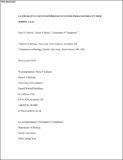Files in this item
A comparative study of how British tits encode predator threat in their mobbing calls
Item metadata
| dc.contributor.author | Carlson, Nora V. | |
| dc.contributor.author | Healy, Susan D. | |
| dc.contributor.author | Templeton, Christopher N. | |
| dc.date.accessioned | 2018-02-21T00:33:09Z | |
| dc.date.available | 2018-02-21T00:33:09Z | |
| dc.date.issued | 2017-03 | |
| dc.identifier | 249195028 | |
| dc.identifier | a8b14f6b-278c-4330-82a9-3d42ec31b03f | |
| dc.identifier | 85013170895 | |
| dc.identifier | 000398050900014 | |
| dc.identifier.citation | Carlson , N V , Healy , S D & Templeton , C N 2017 , ' A comparative study of how British tits encode predator threat in their mobbing calls ' , Animal Behaviour , vol. 125 , pp. 77-92 . https://doi.org/10.1016/j.anbehav.2017.01.011 | en |
| dc.identifier.issn | 0003-3472 | |
| dc.identifier.other | RIS: urn:0460640342B2F9431F3DAD4167D719C2 | |
| dc.identifier.other | ORCID: /0000-0002-8059-4480/work/60631304 | |
| dc.identifier.uri | https://hdl.handle.net/10023/12763 | |
| dc.description | This research funded by NERC (NE/J018694/1), the Royal Society (RG2012R2), the M. J. Murdock Charitable Trust (2014199) and the University of St Andrews (University of St Andrews 600th Year Scholarship and the St Leonard's Fee Scholarship). | en |
| dc.description.abstract | Many species use antipredator vocalizations to signal information about potential predators, including the level of threat posed by a particular predator. It is not clear, however, why only some prey species do this. Because they use multiple mechanisms to encode threat-specific information about predators, North American Paridae species have been a particularly useful model for studying antipredator signals. Paridae as a group are also useful for examining phylogenetic conservation of vocal signals because all of these species (at least those studied previously) employ similar ways of encoding information about predator threat. To test whether the ways in which predator threat information is encoded (here measured by a bird's vocal output) are conserved across a family with similar vocalizations, we used taxidermy mounts to simulate low- and high-threat predators to induce mobbing in six species across five genera of British Paridae. We found that, like North American species, British tits all increased their call rate in response to predators compared with nonthreatening control mounts, but they all varied in the number and types of additional ways they encoded this information. Some species (blue and willow tits) used all four ways to differentiate between different threat predators, while others used only two (crested tits), one (great and coal tits) or none at all (willow tits). The variation in the way each species encoded predator threat information in their calls was not explained by phylogenetic relatedness or by variation in life history. To better understand patterns of information encoding across related species, we suggest that playback experiments to determine how encoded information is used by conspecifics and heterospecifics might provide insights about why some species encode information about predator threat in multiple ways. | |
| dc.format.extent | 16 | |
| dc.format.extent | 1813176 | |
| dc.language.iso | eng | |
| dc.relation.ispartof | Animal Behaviour | en |
| dc.subject | Acoustic communication | en |
| dc.subject | Antipredator behaviour | en |
| dc.subject | Information encoding | en |
| dc.subject | Mobbing | en |
| dc.subject | Paridae | en |
| dc.subject | Predator–prey dynamics | en |
| dc.subject | QH301 Biology | en |
| dc.subject | NDAS | en |
| dc.subject.lcc | QH301 | en |
| dc.title | A comparative study of how British tits encode predator threat in their mobbing calls | en |
| dc.type | Journal article | en |
| dc.contributor.sponsor | NERC | en |
| dc.contributor.institution | University of St Andrews. School of Biology | en |
| dc.contributor.institution | University of St Andrews. Institute of Behavioural and Neural Sciences | en |
| dc.contributor.institution | University of St Andrews. Centre for Social Learning & Cognitive Evolution | en |
| dc.contributor.institution | University of St Andrews. Centre for Biological Diversity | en |
| dc.identifier.doi | https://doi.org/10.1016/j.anbehav.2017.01.011 | |
| dc.description.status | Peer reviewed | en |
| dc.date.embargoedUntil | 2018-02-20 | |
| dc.identifier.grantnumber | NE/J018694/1 | en |
This item appears in the following Collection(s)
Items in the St Andrews Research Repository are protected by copyright, with all rights reserved, unless otherwise indicated.

